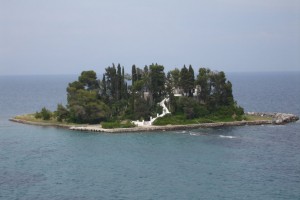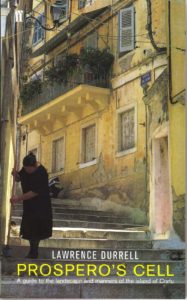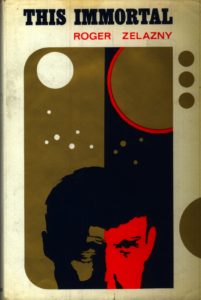Are you a kallikantzaros, destined to terrorise your village for the next few days? Or are you impish and troublesome at this time of the year by choice? Today we recommend a novel, recount some dark folklore and suggest baptism in the Orthodox church. We are in the Twelve Days of Christmas, and thus calling in on Greek folk-legends, shadow puppetry and science fiction. Naturally.
Let’s turn to the author Roger Zelazny, who knew that children born at this time run the risk of turning into those blackened, misshapen goblins known to the Greeks as kallikantzaroi.
Twelvetide has many myths and rituals associated with it across the world. We thought about going with the Hunting of the Wren, but the lure of a particular novel, This Immortal by Roger Zelazny (1937-1995), was too great.

The book was serialised in The Magazine of Fantasy and Science Fiction in 1965 under the title And Call Me Conrad, with some cuts from the original manuscript. Subsequently released in various forms as a novel, the original text was restored, and it became known under the This Immortal title. Zelazny apparently preferred the Conrad title, but the publishers didn’t.
It’s not Zelazny’s best book, but it does introduce some rather neat ideas. And it’s another work showing his fascination with immortal or extremely long-lived central characters. Corwin of Amber, from the Amber series; Sam from the quite brilliant Lord of the Light; Francis Sandow from Isle of the Dead. We covered the last one at length earlier in the year – roger zelazny – my family and other vorvolakas . Another novel full of great ideas, including a man possessed by an alien god.
So what’s the folklore element here? In Greece they have a rather interesting Twelvetide belief, one which is shared in various forms across Southeastern Europe – Serbia, Greece, parts of Turkey and so on. The kallikantzaros is a mischievous creature, a sort of blackened goblin. These goblins are often portrayed as stunted or malformed creatures of various heights, some with animal parts, others with enormous genitalia, or with mis-matched limbs.
The most curious part is their behaviour, which is governed by light and religion. For most of the year, the kallikantzaroi spend their time underground, sawing at the roots of the Tree of the World and trying to bring it down. Echoes of Yggdrasil, the Norse World Tree, and the dragon/demon Níðhöggur which gnaws at Yggdrasil’s roots.

Spurning the light, it is only during the Twelve Days of Christmas when the sun is at its lowest, that the kallikantzaroi emerge into the world of humans to cause trouble. They’re not exactly the most evil goblins, but tricksters and mischief-makers. And some believe that children born during these twelve days may turn into kallikantzaroi (the Serbs called Twelvetide ‘the unbaptised days’). This was to be prevented by various folkloric traditions – surrounding the child with garlic or straw rubbed with garlic, making sure that a priest had blessed them, and, for some odd reason, singeing their toenails.
After causing minor mayhem, such goblins returned underground with the end of the Twelve Days of Christmas, either the 5th or the 6th of January. This must have been frustrating, as in their absence the Tree of the World had healed itself and it was time to pick up that saw again.
Roger Zelazny composted a whole bundle of Greek myths when he came up with This Immortal. You can look for connections not only with the kallikantzaros legend, but with Dionysian tales, the Great God Pan and sundry other beliefs. He has a nice observation about the nature of the Greek goblins in there as well:
“So feathers or lead” I asked him.
“Pardon?”
“It is the riddle of the kallikanzaros. Pick one.”
“Feathers?”
“You’re wrong.”
“If I had said ‘lead’… ?”
“Uh-uh. You only have once chance. The correct answer is whatever the kallikanzaros wants it to be. You lose.”
“That sounds a bit arbitrary.”
“Kallikanzaroi are that way. It’s Greek, rather than Oriental subtlety. Less inscrutable, too. Because your life often depends on the answer, and the kallikanzaros generally wants you to lose.”
“Why is that?”
“Ask the next kallikanzaros you meet, if you get a chance. They’re mean spirits.”
In the book, he references Easter, and the possibility that kallikantzaroi are driven from their work on the World Tree by the Easter bells. This would be fitting, given the importance of East to the Greek Orthodox Church. Χριστὸς ἀνέστη – Kristos aneste – Christ is Risen. In the Orthodox Church, Christmas is really a preliminary to Easter, which is the more significant event in the liturgical year.
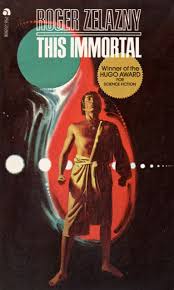
The novel is set on an Earth devastated by war and mostly in ruins, with much of the planet owned by aliens, the Vegans, who come here on sight-seeing trips. Humans live under many stars, mostly as employees or servants of the aliens, who are generally benevolent in their way. Only the Mars and Titan colonies are semi-independent, having had to get along on their own after Earth fell apart. With a disjointed human population, a lot of post-war wreckage and radioactive hot-spots, humanity is not in the best of positions. The Returnist movement has fought, physically and politically, to have their planet back, but with little success.
Enter Conrad. Like Sam in Lord of Light, he has many names. He may be Conrad Nomikos, Konstantin, or the freedom-fighter Karaghios. He avoids being pinned down on that most of the time.
What he is, no-one is sure. He was born during Twelvetide, and may not have been baptised (the priest had a stroke during the ceremony). His girlfriend calls him a kallikantzaros, and as in stories of the imps, he has physical defects. One leg is shorter than the other, and he has a scarred face and heterochromia, appropriate goblin traits.
Conrad’s legendary status is confused between the possibilities of radioactive mutation and mythic origins. Conrad also relates to beasts and to satyrs in the Greek ruins and wildlands, which raises the Pan connection. Zelazny declared that
“I wanted to leave it open to several interpretations—well, at least two. I wanted to sort of combine fantasy and sf… either Conrad is a mutant or he is the Great God Pan. The book may be read either way.”
The Collected Stories of Roger Zelazny, Volume 2: Power & Light
The surname Nomikos means ‘of the law’, but it also links to Nomios, a name for a version of Pan. Nomios was Hermes’ son, and Nomios’ mother was the dryad Penelope. He was an excellent shepherd, a seducer of nymphs, and musician upon the shepherd’s pipes. True to form, Conrad plays the syrinx (panpipes), and has a way with women. Add his odd looks and his seeming immortality, and you have your possibilities.
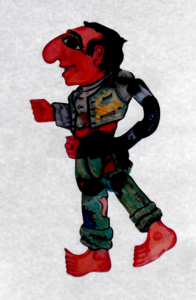
One of Conrad’s names, Karaghiosis, has a very specific link to Greek folk traditions. Long ago we were rattling on about shadow-puppetry with Richard Mansfield of Mansfield Dark, who produce their own excellent style of silhouette and shadow puppet films ( mansfield dark and hans christian andersen: the shadow out of denmark ). It’s a theme which comes up in a number of modern stories, but its roots are ancient. Karagiozis is a shadow puppet and fictional character of Greek folklore, originating in the Turkish shadow play Karagöz and Hacivat.

Kargiozis is a man of apparently little importance, sometimes ignored or slighted, who uses his wiles to get the better of others. Both a hero and an anti-hero. Like Punch, he often has a humped back and other deformities, which links us again to the kallikantzaroi.
Sadly, the puppetry is less common these days, but the shows are still held.
All the figures that represent the characters of the shows are two dimensional and designed always in profile. They were traditionally made from camel skin, carved to allow light through the image, creating details, but are today most often made of cardboard. Traditional puppets gave off black shadows against the white screen, but some more recent puppets have holes covered with colored silk or plastic gel materials to create colored shadows.
The torso, waist, feet and sometimes the limbs, were separate pieces that were joined together with pins. Most figures were composed of two parts (torso and legs) with only one joint to the waist. Two characters, the Jew and Morfonios had joints in the neck, and had a flexible head. They were moved with a stick attached to their ‘back’, except in the case of the figure of Karagiozis, Stavrakas and a few other characters whose arms or other limbs required separate movement. The ‘scene’ was a vertical white parapet, usually a cloth, called mperntes (from Turk. ‘perde’, curtain). Between the figures and the player (who was invisible), were candles or lamps that shed light to the figures and made their silhouettes and colours visible to the audience through the cloth.
Nicked from Wikipedia to save time typing. We’re shameless
Back when we were talking about Zelazny’s Isle of the Dead, we mentioned that the source of the image of that isle is supposedly the island of Pontikonisi, just off Corfu.
By coincidence, the author Lawrence Durrell (brother of Gerald Durrell, My Family and Other Animals) wrote about Karagiozis and the Corfu Greeks:
Their national character is based on the idea of the impoverished and downtrodden little man getting the better of the world around him by sheer cunning. Add to this the salt of a self-deprecating humour, and you have the immortal Greek. A man of impulse, full of boasts, impatient of slowness, quick of sympathy, and inventive as well as assimilative. A coward and hero at the same time…
Prospero’s Cell (1945)
And the Conrad of Zelazny’s This Immortal shows signs of these characteristics as well. We’ll leave Roger Zelazny and the Greeks with this quote from the novel:
“I’m tired of being a gravekeeper, and I don’t really want to spend from now until Easter cutting through the Tree of the World, even if I am a Darkborn with a propensity for trouble. When the bells do ring, I want to be able to say, “Alethos aneste”, Risen Indeed, rather than dropping my saw and running (ring-a-ding, the bells, clackety-clack, the hooves, et cetera). Now is the time for all good kallikanzaroi… You know.”
It’s worth a read. And possibly checking if you were baptised by a Greek Orthodox priest. Best be safe.
Back in a few days, and on a regular schedule as Twelvetide comes to an end – more lurcher madness, weird fiction and art. Do you join us, and Happy New Year, dear listener, if we don’t see you until then…

